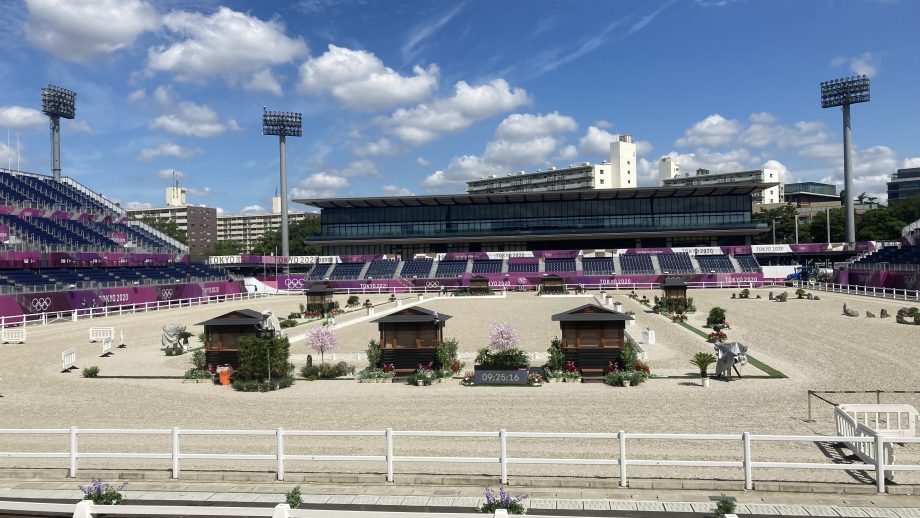I had a lot of worries before we came to the Tokyo Olympics. Who wouldn’t? Travelling across the world in the middle of a global pandemic and keeping up with demanding, shifting paperwork and quarantine requirements was always going to be stressful.
Of course I still have worries, but many of the logistical challenges of Tokyo have proved considerably less of a problem than I expected.
Worry 1: the mixed zone
The mixed zone is the area where athletes come to be interviewed after their performance.
Mixed zones are generally busy places. When it comes to the big-name riders, 15 or 20 journalists are trying to pack around and interview the same person. One day at Rio, I biro-ed the white shirt of a fellow writer in my enthusiasm. It’s quite common for someone else to use your back as a rest for their notebook.
Clearly, this much breathing on each other wasn’t going to be encouraged in a Covid-safe environment.
However, between the organisers and those on the ground (shout out to Andrew McMenamin and Amy Powell) a great system has been put in place. The mixed zone is arranged so that six or eight journalists stand in a U shape around crowd barriers – at a distance of 1m from each other. In the middle of the U, 2m from the journalists, is a cross that the rider stands on. Beside them, a table, with a tray.
The tray. The tray is the genius part of this. Knowing the requirement to stay 2m from athletes, my colleague Polly Bryan and I bought selfie sticks for this trip to allow us to put phones nearer the riders for recording. But the tray removes any need for selfie sticks. Before the interview starts, a volunteer carries it round and we all pop our phones and dictaphones on it. Once we’re done, the volunteer brings the tray back round the group and we grab our devices. It’s simple, but very effective – and even leaves my hands free to take notes.
Check out the tray in the picture above, in which I’m interviewing Canada’s Lindsay Kellock. If you’re not familiar with her story, it’s well worth reading.
There are bound to be mixed zone pinch points in the next few weeks – they are always busier on medal days when mainstream platforms descend – but so far, so good.
Worry 2: transport
As I explained in my last blog, public transport is out of bounds until we’ve been here 14 days and it’s a two-hour plus journey to the venue by official bus.
But since that day when we first travelled in to the Equestrian Park, we’ve had some great news. TOCOG (Tokyo Organising Committee of the Olympic and Paralympic Games) has generously given each member of the media a pile of vouchers to pay for special taxis which are being used as part of the Olympic transport network.
I knew these taxis existed before coming out here, but hadn’t fully appreciated how it would work. I assumed that they would only be available without charge if your journey was actually not feasible via bus. But in fact, the vouchers can be used as we wish within our first 14 days here and the allocation is generous enough that we can pretty much afford to take a taxi to and from the venue daily, cutting our journey down to half an hour.
With the action finishing around 10pm most nights, and plenty of work to do after that, including recording our daily podcast (which can’t be done until we’re back in the hotel – as non-broadcast media, H&H cannot record at the venue), this is is a game-changer. We made it to bed around 2am the past two nights – but it would have been 4am, with an earlier start to get to the venue the next day, without the taxis. So thank you, TOCOG.
Worry 3: food

Tuna poke bowl, courtesy of Tokyo Poke Makers and Uber Eats.
Anyone who has read my blogs from championships before will know I like to eat. My tradition of blogging about how I fill my stomach dates back more than a decade now, to the heady marshmallow-and-caramel-in-a-sweet-baked-potato days of the 2010 World Equestrian Games (forgive the blurry pictures – our website design has changed in the past 11 years…).
As I’ve grown older, my tolerance for missing a meal or two has gone down. Five years ago, I could skip lunch if I was busy and not be too worried. These days, I get headaches and “hanger” – neither are conducive to producing my best work or staying friends with colleagues who I need to work closely with for three weeks.
So heading into Tokyo, I was nervous (and I packed a lot of cereal bars). We had three days of hotel quarantine – but not in a managed hotel set up for this, where they bring you meals. How would we eat? And what would happen after those three days, in a world where we couldn’t go to restaurants or shops and eating was limited to our hotel restaurant (it doesn’t serve dinner) or places at Olympic venues (at the Equestrian Park, it transpires that means a hatch in the press office serving a very limited range of snacks)?
The answer, my friends, is Uber Eats. I have never been so well fed at a championship. There are enough menus available in English (or Google Translate can be helpful), the service is efficient and the food has all been of consistently high quality.
My favourite so far? Poke bowl with virtually raw tuna, hands down.
You might also be interested in:

H&H Olympic reporter’s blog: ‘The venue is breathtaking – let the Games begin’

H&H Olympic reporter’s blog: ‘I’m developing a love affair with Uber Eats’ *H&H Plus*

Tales from Tokyo: ‘I’m wearing a necklace my brother gave me – I know he wants me to be here’

Tales from Tokyo: what Portuguese rider João Miguel Torrão learnt from Carl Hester

Subscribe to Horse & Hound magazine today – and enjoy unlimited website access all year round
Horse & Hound magazine, out every Thursday, is packed with all the latest news and reports, as well as interviews, specials, nostalgia, vet and training advice. Find how you can enjoy the magazine delivered to your door every week, plus options to upgrade your subscription to access our online service that brings you breaking news and reports as well as other benefits.





